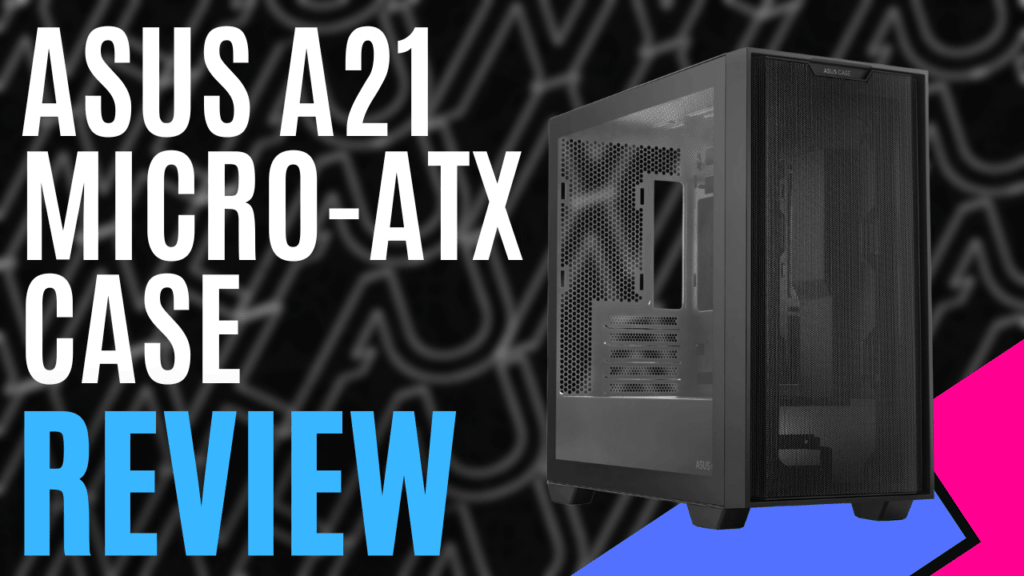
With my focus shifting towards internal PC hardware, I’ve spent a fair amount of time pulling my system apart, installing items for review, testing them out, and then rebuilding back to what it was. This wouldn’t be much of an issue if it wasn’t also my work computer, but it does cause some possible issues with having to constantly install and uninstall drivers and updates. Lance and I had discussed getting a dedicated benchmarking system up and running, but we both got too busy and put the idea aside. Fortunately for us, ASUS has stepped up and offered to help us out, and what better way to start than with a shiny new shell.
Clean and simple in its overall appearance, the ASUS A21 micro-ATX Case is anything but. When you look past the crisp white external frame and the tempered glass panel, you’ll realise that the design allows for smooth and unobstructed airflow. The top, rear, and bottom panels all feature a honeycomb pattern that covers the majority of the surface, while the front and top panels also feature magnetically held quasi-filter mesh, designed to capture larger particles and allow them to be easily removed for cleaning.
The removable front panel also makes the installation and service of up to three 120mm front-facing fans, or a 360mm AIO liquid-cooled radiator, easier, offering plenty of unobstructed working space to move things into position. The design also allows for the light from any RGB cooling to effortlessly flow through the panels, gently illuminating the surroundings. ASUS was also kind enough to include a 3-pack of the TUF GAMING TF120 ARGB Fans.
Featuring 16 LEDs set up in a double-layer array, these will be perfect for the front panel, and I have the option of connecting the supplied multi-function controller to power, with preset options to adjust brightness speed, colour and modes, or I can connect that to an ARGB port on a motherboard, letting Aura Sync take the wheel synchronizing them with other RGB systems I might install.
Removing both the tempered glass and right-side panels is a breeze, and after unscrewing the four factory-supplied thumb screws, the sides simply slide back before lifting away. The inner framework is equally designed for easier maintenance, offering plenty of space to install either a Mini-ITX or a Micro-ATX Motherboard, comfortably fitting up to 380mm graphics card in one of the five available expansion slots, although these can only be horizontally mounted. You’ll certainly want to make use of a GPU bracket if you decide to install one of the larger options.
Alternatively, you could fit up to a 360mm radiator on the top-most panel, making use of the in-laid screw slots that will leave the quasi-filter mesh laying flat on the surface, or mount a smaller, 120mm radiator on the rear. Regardless of what you do here, you’ll still have space available to drop in additional storage, with a single 2.5” drive bay, and two 2.5/3.5” combination bays, with the 2.5” drive bay being hidden on the back side of the motherboard frame, and the two combination bays being tucked in front of the power supply housing.
The FIO is made up of your typical connections, with two USB 3.0 sockets, the power and reset switch, and two 3.5mm connectors for analogue headphones and microphones, though it is designed to be removable should you have any reason to do so. While it may seem insignificant, the ports are nice and grippy, offering clean mechanical connections to whatever device you plug in, and the power/reset buttons provide a satisfying click when pressed.
Installation of your chosen motherboard is also nice and easy, making use of the ready-installed stand-offs and a small bag of screws, and a decent size hole in the frame allows incredibly easy access should you be looking to install one of those aforementioned AIO liquid coolers, ready to drop in your favourite overclockable CPU. Cables can be neatly hidden by routing them through a purpose-built housing that redirects them to the right-side panel, where a 33mm wide cavity will help to hide an unsightly mess.
For those a little more concerned about cable management, there are several handy sections where you can easily feed a number of cable ties through, wrapping the excess cables behind the board and keeping them from slipping into unwanted areas.
Available in either black or white, the ASUS A21 micro-ATX Case delivers in both function and form. A spacious and well-designed interior provides ample space to build your dream PC, be it for work or pleasure, and an easy-to-use cable management network hides those unsightly cables. Honey-combed panels and porous quasi-mesh create a beautifully open airflow system that helps to keep your system cool while glowing RGB emanates from within, illuminating your desk space with beautiful colour.
The Good
- Clean and simple design
- Easy to remove and clean filter panels
- Great airflow capabilities
- Plenty of space for activities
- Great cable management
The Bad
- Doesn’t support vertical GPU mounting












